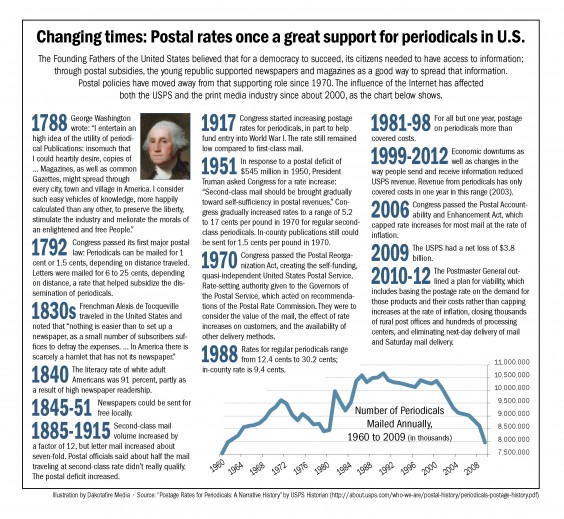By Heidi Marttila-Losure, Dakotafire Media
Reporting by Doug Card, Britton Journal, and Garrick Moritz, Faulk County Record
Weekly newspaper publishers in the Dakotas are concerned about the sweeping changes proposed for the U.S. Postal Service—post office closures, delivery hub closures, rate increases and the possible elimination of Saturday mail delivery—especially since they say the situation is close to terrible for their out-of-county subscribers already.
Weekly newspapers (and magazines) are typically delivered at a periodical rate, and the USPS does not guarantee delivery within any specified time. Within newspapers’ target market—typically their home counties—delivery is rarely delayed, but for delivery to subscribers outside of those areas, there’s really no telling when that newspaper will show up. Sometimes it might arrive just two days after it’s published; sometimes a bundle of three papers arrives more than three weeks later.
“We don’t get any complaints when subscribers get their paper, but we hear plenty of complaints when they don’t get it,” Garrick Moritz, reporter at the Faulk County Record, wrote in an e-mail.
Moritz said that their local postmaster is very good at working with them to make sure the paper is delivered. The problems occur at some point after the newspapers leave Faulk County.
Doug Card said the Britton Journal also has the problem of newspapers being delayed on their way to snowbirds. Another problem came up just recently: The postal service eliminated a truck route from Aberdeen to North Dakota, which means that instead of going from Britton to Aberdeen to North Dakota, they would have to go from Britton to Aberdeen to Huron to Sioux Falls—and then to North Dakota.
“Our papers going to Havana, N.D., 17 miles from Britton, would travel over 500 miles and take four days to be delivered there,” Card wrote in an e-mail.
Both papers have had to come up with their own workarounds for the delivery problems. Moritz said they have started putting their newspapers in envelopes and shipping them via first-class mail, which is more expensive for subscribers but ensures timely delivery. Card said they drive their papers to Havana themselves to ensure those subscribers still get two-day delivery.
Many weekly papers have had distant subscribers switch to e-editions to avoid the postal problems altogether.
But what about out-of-area subscribers who don’t have access to the Internet, or who don’t want to get their news online? Is it possible that postal delivery could get even worse with the proposed USPS changes?
The short answer is yes.
Changes promise savings
No one argues that the USPS isn’t in a dire financial situation. Rules on how the USPS must operate—it must prefund pension plans, for example—and reduced mail volume with the increase in e-mail and online bill payment have kept it from being profitable for years. On March 8, the agency said it will lose $83.2 billion by 2016 without some reforms to its operations.
The changes it says it would like to make are big ones:
- First-class letters and periodicals would no longer have one-day delivery (though the USPS website said local overnight delivery might still be possible, depending on when mail was dropped off, which could ensure local newspaper subscribers still get their paper the next day).
- The elimination of Saturday mail delivery.
- The closure of 223 mail processing centers.
- The closure of 3,830 post offices.
Max Heath, postal committee chair of the National Newspaper Association, said in a video posted on the NAA’s web site that some of these might be bluster, to be used as bargaining chips in its negotiations with Congress, but even partial implementation of these changes would be significant.
According to Savethepostoffice.com, a 30-year veteran mail clerk who spoke at a meeting in Oregon said the closure of a processing center there would result in “massive mail failings,” which would delay delivery of weekly newspapers by several days. If that happens, he said, “You start producing a history, not a newspaper.”
Heath said the first round of post office closings did not have a significant effect on weekly newspapers, based on feedback from the NAA’s members. The next round of closings likely would, however, and the closing of processing centers certainly would.
“(It would be) just totally unreliable as far as being able to give any kind of service to distant mail,” Heath said. “It’s more or less forcing the post office to be only a provider of what’s commonly called last-mile delivery. We’re very concerned that if this goes through that it’ll be ‘Postalgeddon.’ There won’t be any decent delivery of mail outside our trade market.”
In an e-mail to Dakotafire on Monday, Heath advised weekly newspapers “to move everyone to digital that is willing to go.”
“Many of our senior subscribers, core readers of our papers such as snowbirds, etc. are not ready for reading e-subscriptions, so they might just leave,” Heath wrote. “[B]ut poor delivery of distant subscribers is a 20-year trend that doesn’t promise to get any better.”
Heath said it’s not a time to panic—the USPS is not going to close, and six-day delivery is guaranteed through at least Sept. 30 and likely longer (Congress guaranteed it through the end of the fiscal year, and if it is eliminated there will be a six-month warning of the change). Instead, Heath said, it’s time to act.
Heath encouraged NAA member newspapers to lobby their congresspeople to keep postal services intact. The newspaper associations of South and North Dakota also started lobbying campaigns to keep mail service at six days a week.
The NDNA gathered nearly 4,100 signatures in their “Deliver the Mail: North Dakotans for Timely Mail Delivery” campaign, indicating strong support among North Dakotans, according to Roger Bailey, executive director of the NDNA.
“We set a target of 100 signatures from each newspaper but in realty had hoped to get as many as 2,500 people to sign,” Bailey said in a press release on the NDNA website. “Getting more than 4,000 signatures in such a short time was a bonus.
They sent those signatures on to the U.S. Postmaster General, N.D. senators and their representative, and so far have received two responses.
Dave Bordewyk, SDNA general manager, took the South Dakota petition to S.D. legislators and postal regulatory commissioners in Washington last Friday.
“Postal reform is high on the radar right now in Congress, so the timing was perfect,” Bordewyk said, adding that the Senate would need to move on reform legislation in the next few weeks if the implementation of many of the planned changes is to be avoided.
The South Dakota petition had 2,598 signatures and many comments, including:
- “A dependable, timely delivery mail system should be a product of our society, something we cannot do individually but jointly, for the benefit of all. Its value is beyond measure. Expecting it to be “profitable” is as unrealistic as asking Congress to prove its worth!”
- “As rural South Dakota ranchers we rely on our mail service to deliver our parts and veterinary supplies the next day. Not three or more days later. We need our mail delivered in a timely fashion. Living far away from available retailers it is necessary for the mail to deliver to us at least 6 days a week.”
- “6 day mail service is vitally important to me. My husband depend on this form of service for the delivery of our medications, we have been using this method for quite a number of years. And with the shortage of some medications, we have noticed a slower delivery time. We send all our payments by mail, no computer stuff for us, also receive a daily newspaper. If we lose a 6 day service, we will probably drop our newspaper, and this may be what others will do. That will affect the major newspapers, a loss for them. Any packages mailed from our address are sent and received through our daily mail service. Our 6 day mail service is a link to the outside world because we live in a very rural area of SD.”

Changing times: Postal rates once a great support for periodicals in U.S. (Click on the image for a larger version)
![]()
See related story: Savings from closing post offices ‘not even a drop in the bucket’ of USPS budget
 Dakotafire Get your spark here.
Dakotafire Get your spark here.



